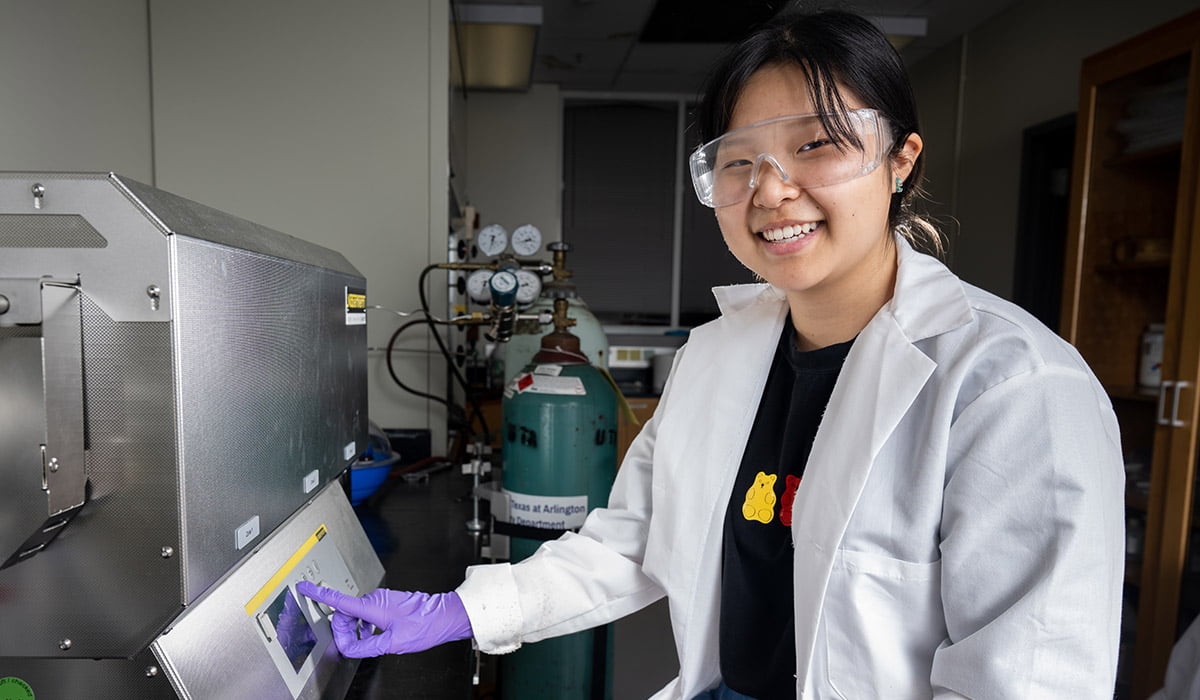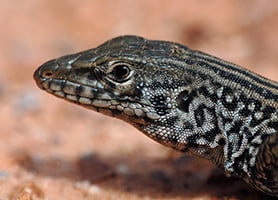University Administration Building
701 S. Nedderman Drive, Ste 421
Arlington, TX 76019-0116
Trial & Discovery
When a freshman researcher had to end an experiment prematurely, she was sure it was a failure—or was it? This is the story of what happens when student researchers are given room to try, to fail, and to explore their curiosity wherever it may take them.
BY LINSEY NAZIR
Melissa Orr’s first project as a freshman research assistant did not go according to plan.
Robin Macaluso, associate professor of chemistry, had welcomed Orr to her inorganic chemistry research lab with a brief assignment to make a four-part chemical compound. The synthesis was straightforward: Grind a few powders, mix them together, heat the compound in a furnace, and remove it once it cools to room temperature.
Orr had followed instructions precisely, heating the compound to a high temperature. As the material cooled, her time was running short. She needed to leave, but the furnace was still at 200° Celsius. After consulting with Dr. Macaluso, Orr popped open the metal door and extracted the sample.
At first glance, it seemed that the experiment had failed. Her compound was red instead of the anticipated yellow. Orr’s innate curiosity prompted her to snap photos and scribble detailed notes depicting the anomaly. Little did she know that as she conducted her careful observation, she was standing on the brink of a scientific discovery.
By opening the furnace door mid-process, Orr had inadvertently uncovered a new physical behavior of the compound. In the following days, her interrupted experiment revealed new information that would go on to inspire a shift in Macaluso’s research interests, several publications co-authored with her students, and collaborations with researchers from other institutions.
Melissa’s accidental discovery in the lab is really the essence of hard work combined with scientific knowledge and experience,
says Macaluso. As a professor, I find that training curious students to make careful observations, investigate those observations, and relate to scientific theory is one of the most rewarding experiences. These are ultimately the necessary components for exciting innovation and advancements in knowledge.

Chemical Curiosities
Macaluso had only been employed at UTA for a few weeks when Orr approached her one afternoon after a general chemistry class and asked to join Macaluso’s lab as an assistant. As Macaluso was still in the process of setting up her lab and staffing her research initiatives, it was a welcome request.
It’s a standard practice to induct new members of the lab with a simple project. The initiation helps newcomers get familiar with the space and demonstrates their current skill level. Macaluso instructed Orr to recreate a lead vanadium oxychloride, which she was interested in for its potential applications to alternative energy materials.
Later, Orr brought the seemingly failed experiment to Macaluso, who was curious about the result. She told her student to try to replicate it. When Orr returned with the same results, Macaluso knew there was more to the compound than meets the eye.
That discovery was transformative for our research,” Macaluso says. “After unveiling the unique properties of that material, we were inspired to expand our analytical methods to learn more about its structure and how it could help us design new materials.
In the years that followed, Macaluso’s research branched into collaborations with Texas A&M University and Bates College, spawned more than a dozen publications, and earned numerous funding awards. In 2021, Macaluso received a two-year grant to fund her lab’s research into creating new synthetic materials that can improve metal oxides for use in a variety of energy-saving applications. The goal of the study is to develop materials that can make a positive impact in solar energy technology and ultimately help address society’s ever-increasing need for reliable sources of energy.
Along the way, she has delegated research questions to her undergraduate and graduate students, providing them with opportunities to produce their own work.
Research experience is an excellent opportunity for students to gain valuable technical skills and work competencies,” Macaluso says. “Being in the lab makes theories and formulas from the classroom come alive, and students gain an understanding of how much care and thoughtfulness go into successful experiments.
As Macaluso closely mentored the cohort of young scientists in her lab, Orr’s research interests grew deeper.

Inside the Furnace
From the moment she learned about the periodic table during an elementary school science lesson, Orr was struck by the power of chemistry.
Even as a kid, it blew my mind that everything we can conceive of is composed of some combination of elements on the periodic table,
Orr says. Roughly 100 elements make up everything we’ve ever known.
Her fascination grew when a high school course offered a different view of history, where humanity’s progress was marked by its most used materials. The ancient world advanced through the Stone, Bronze, and Iron ages. Even now, Orr anticipates the globe’s transition beyond the Silicon Age.
From Orr’s perspective, scientific achievement and human progress are bound to material advances. She points to the field of medicine, where, for example, the development of synthetic hydrogels has resulted in improved prosthetics for individuals with missing limbs.
Many problems that society encounters, if you trace them back to their origin, begin with a lack of material,
she says. Materials are fundamental to problem solving.
As an amateur baker and sourdough enthusiast, she compares materials science to developing a new recipe.
The first person to bake angel food cake had to come up with that recipe, which is not easy to do,
Orr says. There is a lot of trial and error to make a compound that nobody has ever made.
She notes that when making sourdough at home on the weekends, she can look through the oven’s transparent window to get an idea of its rise, color, and texture. Lab furnaces, on the other hand, typically do not have such windows, making direct observations of the reaction impossible. Without peering into the process as it happens, that privileged information is lost, and the scientific community is left in the dark.
Working in Macaluso’s lab, Orr formed a collaboration with scientists at Northwestern University to perform operando experiments, where she uses in situ X-ray experiments to monitor chemical reactions within the furnace. These experiments satisfy a curiosity that was sparked by her first project in Macaluso’s lab.
At Northwestern, Orr probes the crystalline structure of materials as they respond to changes in temperature. Those observations could help her identify brand new materials.
Melissa’s research has exploded,
Macaluso says. No one else is really digging into these questions the way that she is.

Trial and Error
Seven years after the lead vanadium oxychloride discovery, Orr is a busy doctoral researcher under Macaluso’s supervision.
They say the definition of insanity is doing the same thing over and over again, expecting different results,
Orr says. As we progress through each experiment, we make small adjustments and look for new information.
These days, her focus is on establishing relationships among the synthesis, structure, and properties of oxygen and tellurium compounds, which are largely unexplored and could be promising for green energy applications. Looking ahead, Orr hopes to realize oxytelluride materials for practical use by creating thin films, which may be useful in advanced technologies.
To achieve a moment of revelation, Orr says that initial act of observation, of focusing one’s attention on the individual variables of an experiment, is the foundation of what she does as a solid-state chemistry researcher. An experimentalist, Orr believes it takes all of one’s senses to investigate a scientific problem.
Scientists are not perfect. It’s very easy to impose what you want to happen onto the results of an experiment,
Orr says. Objective observation is critical. Despite the technology we use and the measurements that we can make now, human beings still have incredible insight that should not be negated.
Orr leads by example and encourages her students to listen to their instincts and trust their observations.
I tell the undergraduates I mentor there is a lot of trial and error in the lab, but every time you fail, you are contributing to the scientific body of knowledge,
she says. Even if you’re a freshman, or a juvenile scientist, you can still stumble on something that’s really interesting.
For Akari Kojima, a pre-health studies student and undergraduate research assistant, that encouragement gives her the confidence to speak up and try new strategies. In her role, she assists Orr with experimentation to develop new oxygen and tellurium compounds.
We are trying to create something that doesn’t exist, so at the end of our experiments and observations, we are literally in a position of not knowing what to do next,
Kojima says. Even though I am new, it is important for me to offer different ideas. There’s strength in collaboration.
Having worked in Macaluso’s lab for only a year, Kojima’s name already resides next to her mentor’s name on a publication byline.
Orr, Kojima, and other student contributions stand as a testament to Macaluso’s generational legacy of mentoring in the classroom and the lab. Behind every hypothesis, experiment, and observation, there is the steady creed that every voice has value, no detail should go overlooked, and that scientific curiosity is the only requirement.
You Might Also Like

DEEP DIVE INTO CORAL PLAGUE
A team of researchers studying how seven reef-building coral species in the Caribbean respond to white plague disease.

GENETICS ON THE SPECTRUM
A team led by biologists at UTA has published a study supporting the theory that species that reproduce asexually have more harmful genetic mutations than those utilizing sexual reproduction.

HONORING THE PAST, FORGING THE FUTURE
UTA’s support of Native American students and communities spans several decades. Today, the community is strong than ever and looking forward to a bright future.